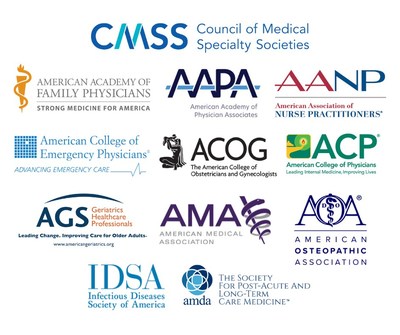Given the anticipated increase in COVID-19 and influenza cases this fall and winter, America’s healthcare professional organizations are coming together to remind the public of the importance of vaccinations and early treatment.
| Statement from: American Academy of Family Physicians, American Association of Nurse Practitioners, American Academy of Physician Associates, American College of Emergency Physicians, American College of Physicians, American College of Obstetricians and Gynecologists, American Geriatrics Society, American Medical Association, American Osteopathic Association, Council of Medical Specialty Societies, Infectious Diseases Society of America, and AMDA – The Society for Post-Acute and Long-Term Care Medicine WASHINGTON, Nov. 21, 2022 /PRNewswire/ -- Given the anticipated increase in COVID-19 and influenza cases this fall and winter, America’s healthcare professional organizations are coming together to remind the public of the importance of vaccinations and early treatment. A strong recommendation from a trusted clinician is one of the most effective strategies to increase vaccine uptake. We encourage our members to use every interaction with patients as an opportunity to make strong vaccine recommendations, educate and answer questions about prevention and treatment options, encourage vaccination, and where feasible provide vaccination. We strongly recommend that everyone who is eligible, especially those at higher risk, urgently receive their updated COVID-19 booster (or COVID-19 primary series if not yet vaccinated) and influenza vaccine. We strongly recommend that everyone who is eligible, especially those at higher risk, urgently receive their updated COVID-19 booster (or COVID-19 primary series if not yet vaccinated) and influenza vaccine. We expect that the updated COVID-19 vaccine will help reduce severe illness, hospitalizations and death for our most vulnerable patients, including older adults, those who are pregnant and recently pregnant, and those from historically minoritized communities. We urgently ask all clinicians to be vigilant and prioritize vaccination in the coming months. To maximize uptake of vaccines after counseling, our organizations will continue to advocate for access to vaccines and evidence-based treatments for everyone. Given the higher morbidity and mortality among older people, those who are pregnant and recently pregnant, and immunocompromised people, we strongly recommend that healthcare professionals increase their timely use of effective treatments. While newer variants may not respond to some existing treatments, healthcare professionals must be ready and able to prescribe life-saving oral antiviral treatments for COVID-19 and influenza, to those at highest risk. It is critical that everyone, especially those at risk for serious illness, understand the importance of testing and early communication with their clinicians to seek treatment as soon as they test positive. We commit to continue working with federal partners to provide usable and consistent information and emerging evidence-based tools that we can rapidly push to our members. The time to act is now, and the nation’s organizations of healthcare professionals are ready and willing to do all we can to encourage vaccination and use of evidence-based treatments in the critical months ahead. About American Academy of Family Physicians: Founded in 1947, the AAFP represents 127,600 physicians and medical students nationwide. It is the largest medical society devoted solely to primary care. Family physicians conduct approximately one in five office visits -- that’s 192 million visits annually or 48 percent more than the next most visited medical specialty. Today, family physicians provide more care for America’s underserved and rural populations than any other medical specialty. Family medicine’s cornerstone is an ongoing, personal patient-physician relationship focused on integrated care. To learn more about the specialty of family medicine and the AAFP’s positions on issues and clinical care, visit www.aafp.org. For information about health care, health conditions and wellness, please visit the AAFP’s consumer website, www.familydoctor.org. About American Association of Nurse Practitioners: The American Association of Nurse Practitioners® (AANP) is the largest professional membership organization for nurse practitioners (NPs) of all specialties. It represents the interests of the more than 355,000 licensed NPs in the U.S. AANP provides legislative leadership at the local, state and national levels, advancing health policy; promoting excellence in practice, education and research; and establishing standards that best serve NPs’ patients and other health care consumers. To locate an NP in your community, visit npfinder.com. For more information about NPs, visit aanp.org. About the American Academy of Physician Associates (AAPA): AAPA is the national membership organization for all PAs (physician associates/physician assistants). PAs are licensed clinicians who practice medicine in every specialty and setting. Trusted, rigorously educated and trained healthcare professionals, PAs are dedicated to expanding access to care and transforming health and wellness through patient-centered, team-based medical practice. PA has been named one of the best jobs overall and one of the best healthcare jobs for the fifth year in a row by U.S. News & World Report. The PA profession ranked number three this year in Best STEM jobs. Learn more about the profession at aapa.org and engage through Facebook, LinkedIn, Instagram, and Twitter. About the American College of Emergency Physicians: The American College of Emergency Physicians (ACEP) is the national medical society representing emergency medicine. Through continuing education, research, public education, and advocacy, ACEP advances emergency care on behalf of its 40,000 emergency physician members, and the more than 150 million people they treat on an annual basis. For more information, visit www.acep.org and www.emergencyphysicians.org. About the American College of Physicians: The American College of Physicians is the largest medical specialty organization in the United States with members in more than 145 countries worldwide. ACP membership includes 160,000 internal medicine physicians, related subspecialists, and medical students. Internal medicine physicians are specialists who apply scientific knowledge and clinical expertise to the diagnosis, treatment, and compassionate care of adults across the spectrum from health to complex illness. American College of Obstetricians and Gynecologists: The American College of Obstetricians and Gynecologists (ACOG) is the nation’s leading group of physicians providing health care for women. As a private, voluntary, nonprofit membership organization of 60,000 members, ACOG strongly advocates for quality health care for women, maintains the highest standards of clinical practice and continuing education of its members, promotes patient education, and increases awareness among its members and the public of the changing issues facing women’s health care. www.acog.org. About the American Geriatrics Society: Founded in 1942, the American Geriatrics Society (AGS) is a nationwide, not-for-profit society of geriatrics healthcare professionals dedicated to improving the health, independence, and quality of life of older people. Our 6,000+ members include geriatricians, geriatrics nurse practitioners, social workers, family practitioners, physician assistants, pharmacists, and internists who are pioneers in advanced-illness care for older individuals, with a focus on championing interprofessional teams, eliciting personal care goals, and treating older people as whole persons. AGS believes in a just society, one where we all are supported by and able to contribute to communities where ageism, ableism, classism, homophobia, racism, sexism, xenophobia, and other forms of bias and discrimination no longer impact healthcare access, quality, and outcomes for older adults and their caregivers. AGS advocates for policies and programs that support the health, independence, and quality of life of all of us as we age. https://www.americangeriatrics.org/. About the American Medical Association: The American Medical Association is the physicians’ powerful ally in patient care. As the only medical association that convenes 190+ state and specialty medical societies and other critical stakeholders, the AMA represents physicians with a unified voice to all key players in health care. The AMA leverages its strength by removing the obstacles that interfere with patient care, leading the charge to prevent chronic disease and confront public health crises, and driving the future of medicine to tackle the biggest challenges in health care. About the American Osteopathic Association: The American Osteopathic Association (AOA) represents more than 178,000 osteopathic physicians (DOs) and osteopathic medical students; promotes public health; encourages and funds scientific research; serves as the primary certifying body for DOs; and is the accrediting agency for colleges of osteopathic medicine. To learn more about DOs and the osteopathic philosophy of medicine, visit www.osteopathic.org. About the Council of Medical Specialty Societies: The Council of Medical Specialty Societies (CMSS) is a coalition of 50 specialty societies representing more than 800,000 physicians across the house of medicine. As the national organization of specialty societies, CMSS provides a proactive platform to assess and address emerging issues across specialties that influence the future of healthcare and the patients we serve. About the Infectious Diseases Society of America: The Infectious Diseases Society of America (IDSA) is a community of over 12,000 physicians, scientists, and public health experts who specialize in infectious diseases. Its purpose is to improve the health of individuals, communities, and society by promoting excellence in patient care, education, research, public health, and prevention relating to infectious diseases. Learn more at https://www.idsociety.org/. About AMDA – The Society for Post-Acute and Long-Term Care Medicine: AMDA – The Society for Post-Acute and Long-Term Care Medicine is the only medical specialty society representing the community of over 50,000 medical directors, physicians, nurse practitioners, physician assistants, and other practitioners working in the various post-acute and long-term care (PALTC) settings. Dedicated to defining and improving quality, we advance our mission through timely professional development, evidence-based clinical guidance, and tireless advocacy on behalf of members, patients, families, and staff. Visit www.paltc.org for more information.
SOURCE American College of Physicians |





